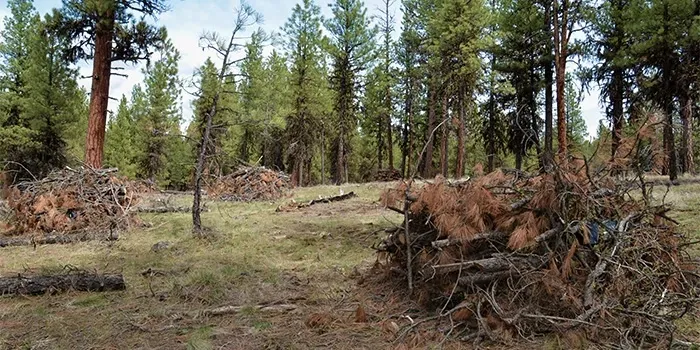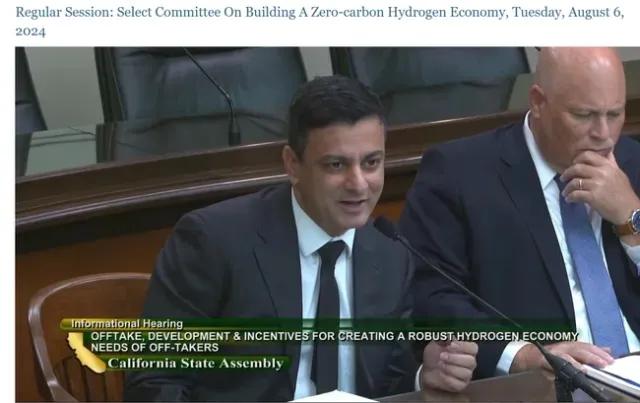When seeking to make forests more fire resilient, removing fuels from the landscape is a tough task to make cost-effective. Thinning and limbing trees during fuels reduction treatments will sometimes produce marketable timber, but more often will produce small-diameter wood pieces that have traditionally been considered unmarketable. These pieces are typically chipped, masticated, or pile burned, and have long been considered ‘wood waste’.

California researchers, industry leaders, and private forest landowners have been looking at ways to transform forest wood waste, particularly in wildfire-prone areas, into sustainable products. Utilizing forest biomass for building materials, soil amendments, and clean energy is a key strategy to economically incentivize improving forest conditions and can address both public and private industry needs.
The state has also been making moves to decrease greenhouse gas emissions and aims to eliminate emissions entirely by 2045. Biomass-derived hydrogen (biohydrogen) a zero-emission alternative to fossil fuels, offers an exciting opportunity for advancing the state towards its zero-emissions goal while also addressing the buildup of forest fuels.
Biohydrogen is produced through the gasification of woody residues sourced from fuel reduction and other forest treatment projects. Converting wood waste into usable products creates a regional, closed loop system that not only adds to the low-carbon fuel market but can also provide a benefit to forested communities by creating jobs and reducing wildfire risk. California has invested time, money, and research in this sector, but challenges remain. One of the biggest hurdles to increasing bioenergy production is a lack of adequate infrastructure.
One solution posited by UC ANR Biomass and Bioenergy Advisor Haris Gilani is this: can the state breathe new life into old sawmills, and transform them into biohydrogen production sites? Gilani is leading a new CAL FIRE-funded project which seeks to answer this question, while facilitating the public and private connections necessary for implementation. The establishment of biohydrogen sites, or campuses, has the added benefit of stimulating economic growth in rural areas through job creation and local tax revenue increases.

By seeking to facilitate the commercialization of forest biomass-based hydrogen and developing the necessary markets, this project has the potential to yield significant economic and environmental returns for rural communities. Gilani’s team will be evaluating the bioenergy campus potential in two counties: Fresno and San Bernardino. “By using the excess of biomass that we already have, we can help protect communities from wildfire risk, improve air quality, and advance statewide environmental goals,” notes Gilani.
This project aims to address needs throughout the supply chain by assessing available forest biomass resources, identifying existing and potential businesses and suppliers, evaluating workforce training needs, and providing direct support to attract and foster business growth in the two regions. Through collaboration with public and private partners like San Bernardino County, ATIP Foundation, NovoCarbo, Fresno County Economic Development Corporation, San Bernardino Economic Development, and Sierra Resource Conservation District, Gilani’s team will also identify old sawmill sites and assess the feasibility of repurposing into bioenergy campuses.
An established statewide bioenergy campus network would be a welcome resource for small, non-industrial landowners in California grappling with the cost of managing their land. One UC ANR study found that landowners throughout the state “overwhelmingly listed cost as their major barrier to [management] action”, and many “have paid for work done on their property themselves.”
“Landowners are a critical part of the supply chain,” says Gilani. “They would experience economic benefits from a thriving biohydrogen industry, as revenue from biomass sales could help offset the cost of forest management projects.” A crucial piece of Gilani’s project is stakeholder outreach, and he aims to host workshops to gain support from Fresno and San Bernardino landowners for this initiative.
In addition to the creation of two bioenergy campuses, Gilani seeks to ensure other rural areas can replicate the effort to leverage biomass resources to support their economies. “This is about supporting landowners, strengthening rural economies, and turning a challenge into a sustainable opportunity for California,” says Gilani. He and his team will create and publish strategic business plans for the Fresno and San Bernardino projects, with the hope that these two campuses are just the beginning of a statewide effort.
For more information about this project, visit this 2024 UC ANR policy brief, or contact Haris Gilani at hgilani@ucanr.edu, .

